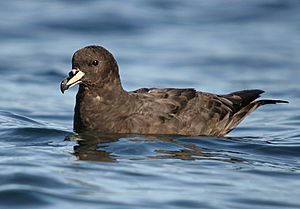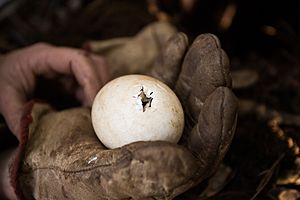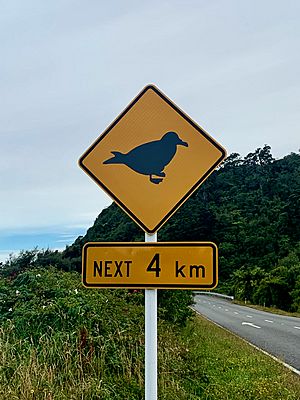Westland petrel facts for kids
Quick facts for kids Westland petrel |
|
|---|---|
 |
|
| Conservation status | |
| Scientific classification | |
| Genus: |
Procellaria
|
| Species: |
westlandica
|
The Westland petrel (Procellaria westlandica), also called the Westland black petrel or tāiko, is a medium-sized seabird. It belongs to the petrel family Procellariidae and lives in New Zealand.
Contents
What Does the Westland Petrel Look Like?
The Westland petrel is a strong, dark bird. It weighs about 1100 grams, which is a bit more than a big bag of sugar. Its feathers are dark blackish-brown, and its legs and feet are black. Some birds might have a few white feathers. Its beak is light yellow with a dark tip. The Māori name for this bird is tāiko. This name is also used for another bird, the black petrel (Procellaria parkinsoni).
Where Do Westland Petrels Live?
The Westland petrel lives only in New Zealand. It is an endemic bird, meaning it's found nowhere else naturally. It is listed as an Endangered species, which means it's at high risk of dying out. These birds breed only in a small area on the West Coast of New Zealand's South Island. This special breeding area is about 8 kilometers wide. It stretches between Barrytown and Punakaiki.
They nest in burrows, which are like tunnels, dug into hillsides. These burrows are usually 1 to 2 meters deep. Many of their nesting places are on steep slopes. In 2014, a big storm called Cyclone Ita damaged some of these sites. There are about 29 groups of petrels, called colonies, in this area. Each colony can have between 50 and 1000 burrows. These colonies are found from 50 to 200 meters above sea level.
During the breeding season, adult Westland petrels can be seen in the waters around New Zealand. This includes areas from Cape Egmont to Fiordland on the west, through the Cook Strait, and from East Cape to Banks Peninsula on the east. They also fly over parts of the Pacific and Tasman Seas. When it's not breeding season, they fly east to waters near South America. They find food in the Humboldt Current off the coast there.
Westland Petrel Life Cycle and Reproduction
Westland petrels spend most of their lives at sea. They only come to land to breed and raise their young. They are winter breeders, meaning they start their nesting in the colder months. They arrive at their breeding spots in late March or early April each year. They get their burrows ready for nesting. About three weeks before nesting, the colonies become very noisy. This is when the birds find their mates. Petrels usually stay with the same partner for their whole lives.
The female bird lays one egg between May and June. The egg hatches about two months later, in August or September. Both the male and female take turns sitting on the egg to keep it warm. After the chick hatches, the parents care for it for about two weeks. After that, the chick is left alone in the burrow but is fed by its parents at night. If one parent dies, the chick usually won't survive.
Young birds usually don't fly for another two months after hatching. They change their feathers (moult) during their non-breeding season. For Westland petrels, this is from October to February, when they migrate to South America. Younger birds moult before older ones. Raising a chick takes between two and four months in total. After leaving their nests, young birds might not return for up to 10 years. From late September to late November, Westland petrels fly to South American waters, often near Chile. They usually travel alone during this time. They rejoin their colony when the next breeding season starts.
What Do Westland Petrels Eat?
Petrels hunt at night because they are nocturnal. They mostly eat fish, but also some squid and sometimes small crustaceans. Westland petrels are known to eat fish scraps from fishing boats. This happens during their breeding season when it overlaps with the fishing season. At other times, they hunt for their own food.
They catch their food in different ways. They can grab prey from the surface of the water. They can also dive into the water from the surface. Sometimes, they dive deeper to chase fish. They have been seen diving up to 8 meters deep! Their strong eyesight helps them spot food. Recent studies show that their sense of smell is also important for finding food. Certain smells seem to attract them to good hunting areas.
Who Are the Westland Petrel's Predators?
Predators of the Westland petrel include stoats, rats, and weka. These animals attack during the breeding season when the birds are on land. They prey on chicks in open burrows and on adult birds. Wild cats and dogs also sometimes hunt petrels, but not very often. These predators are not thought to be a big danger to petrel colonies.
However, there are concerns about cattle and goats. They can accidentally step on and destroy burrows. This can make it easier for predators like weka to reach the birds inside.
Not much research has been done on diseases and parasites in New Zealand seabirds. So far, no diseases have been found to be a major problem for Westland petrels. A disease called avian pox might be a threat. It has killed some black petrel chicks. Other diseases have been found in different seabirds, but not linked to Westland petrels.
Other Interesting Facts About Westland Petrels
The Westland Petrel was officially identified in 1945. This happened after students from Barrytown School wrote to Robert Falla. He was the director of the Canterbury Museum at the time. The students had heard about another bird, the sooty shearwater (also called muttonbird), on the radio. But they noticed that the "mutton birds" in their area acted differently. They even sent Falla a dead bird. Within a few weeks, he visited the West Coast. At first, he thought the West Coast birds were a type of Black Petrel. But soon, they were classified as a completely separate species.
Even though they don't have many natural predators, human activities threaten them. Power lines, bright lights, and commercial fishing are dangers to Westland petrel populations. Adult petrels can crash into power lines while flying. Lights can also confuse and disorient the birds, especially young ones. This often causes them to land on the ground. This is a big problem because Westland petrels need to take off from high places. To fly, they climb tall trees and launch themselves into the air. If they land on the ground too early, they can die from hunger, thirst, predators, or hitting human-made structures.
Commercial fishing also causes problems. It means less food for the petrels. Sometimes, petrels get caught by accident in fishing nets. This is a big risk for Westland petrels. They often eat waste from fishing boats, so they are known to be close to these vessels.
Westland petrels are interesting because there is still much we don't know about them. Studies are mostly done during their breeding season when they are on land. This makes it hard to study their behavior at sea. Very little is known about how they act socially in their colonies. Some questions have been asked about their calls, but this topic hasn't been studied much.
Tāiko Festival
Every year, a festival is held in Punakaiki to celebrate the petrel's return home. This area is known as the home of the Westland petrel, or tāiko (as locals call it). This is because it's the only place where they are known to breed. It's a weekend-long festival in April. It includes live music, different fun activities, and a local market. The festival starts with watching the birds fly overhead at dusk as they head to their nests in the mountains.
Images for kids
See also
 In Spanish: Pardela de Westland para niños
In Spanish: Pardela de Westland para niños






